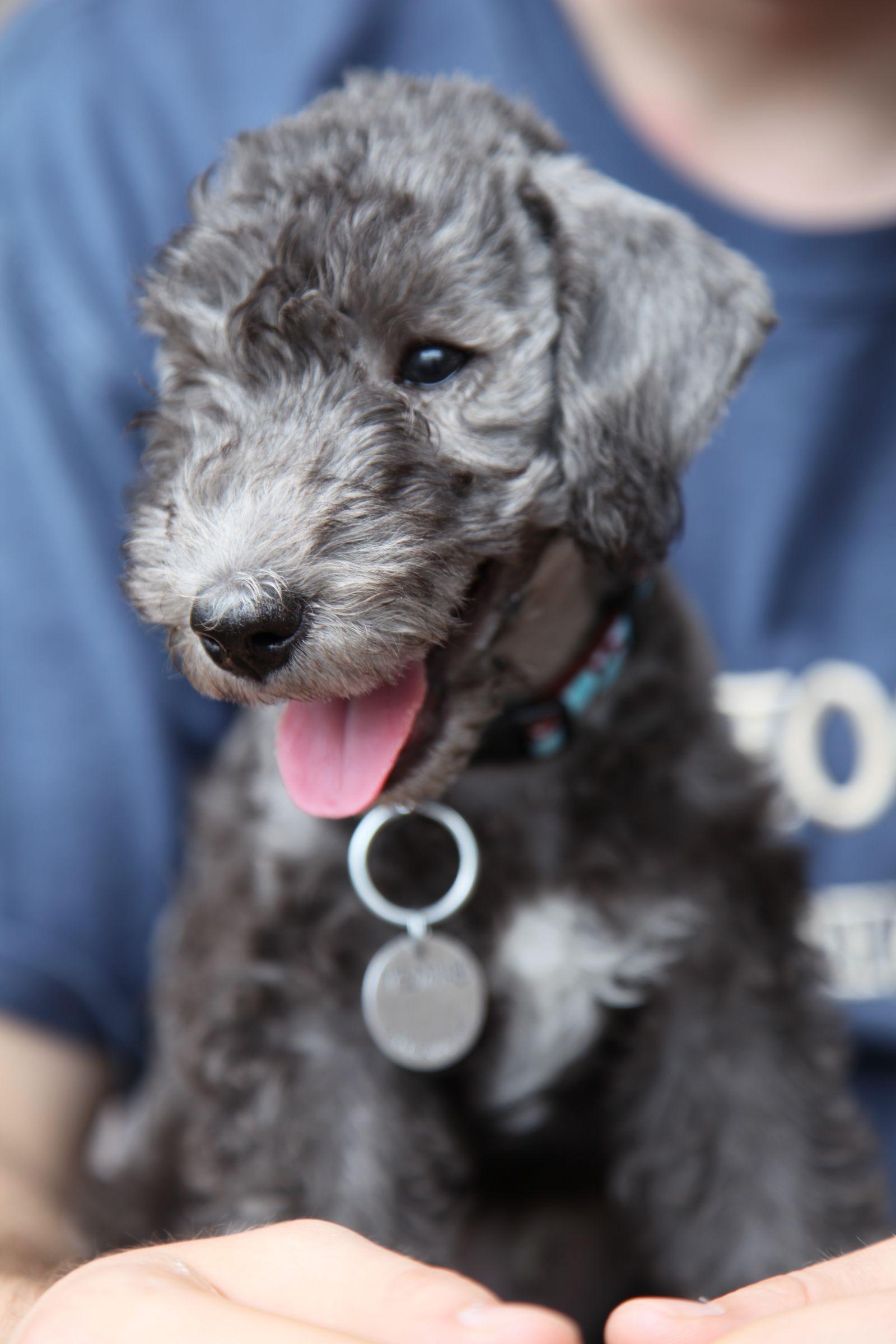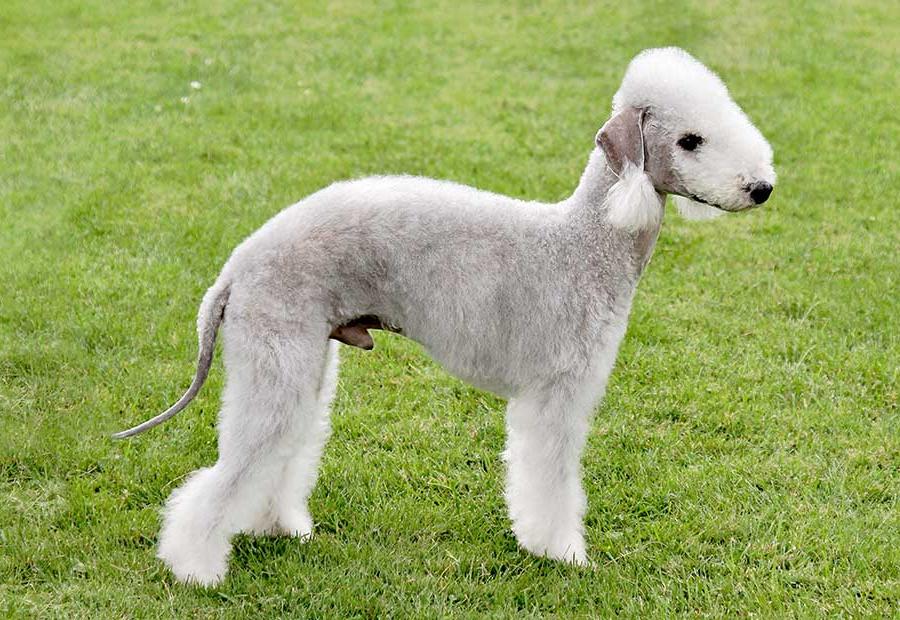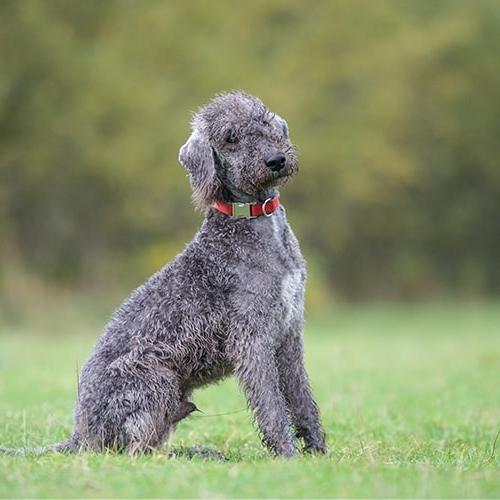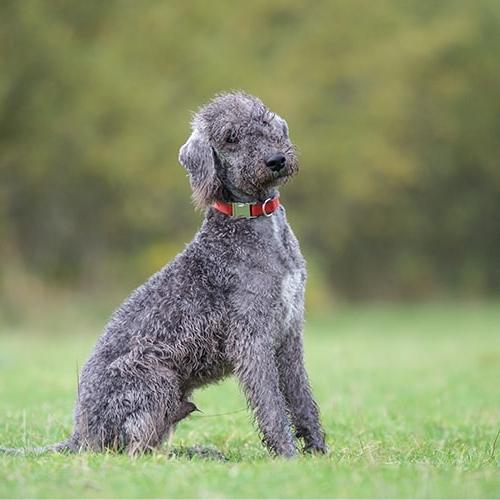- Breed Category: Terrier
- Country of Origin: United Kingdom
- Average Height: 38-44 cm; 15-17 inches
- Average Weight: 8-10 kg; 18-23 pounds
- Average Life Span: 12-14 years
- Grooming Requirements: Regular trimming and brushing needed
- Exercise Requirements: Moderate daily exercise
- Coat Type: Curly and woolly
- Coat Color Variations: Blue, liver, sandy
- Shedding Level: Low
- Ear Type: Drop ears
- Tail Type: Tapered, carried high
- Temperament: Affectionate, lively, intelligent
- Intelligence Level: High
- Barking Tendency: Moderate
- Compatibility with Children: Good with proper socialisation
- Compatibility with Other Pets: Generally good with other dogs
- Training Ease: Relatively easy to train
- Common Health Issues: Copper toxicosis, eye problems
- Dietary Needs: Balanced diet, watch for weight gain
- Energy Level: High
- Drooling Tendency: Low
- Sensitivity to Weather: Sensitive to extreme temperatures
- Overall Maintenance Level: Moderate
- Original Purpose: Hunting vermin and game
- Year of Recognition by Kennel Clubs: 1877
- Apartment Friendly: Yes, with sufficient exercise
- Best Suited For: Active families, experienced owners
- Cost of Ownership: Moderate to high
- Unique Traits: Lamb-like appearance
- Popularity Rank: Moderately popular
Ever found yourself wondering which dog breed would fit perfectly into your life? Choosing the right one can be a bit of a puzzle. Enter the Bedlington Terrier, a breed that might just tick all your boxes. Known for their lamb-like appearance and spirited nature, these dogs are more than just a pretty face. They bring a unique blend of charm and energy to any household.
In this article, we’ll dive into the Bedlington Terrier’s fascinating history, explore their distinctive characteristics, and offer insights into their care. Originating from the mining towns of Northumberland, England, these terriers were initially bred for hunting vermin. Over time, they’ve evolved into beloved companions, known for their intelligence and affectionate nature.
Early Development and Historical Significance of the Bedlington Terrier

Early Development of the Breed
The Bedlington Terrier’s roots trace back to the 19th century in Northumberland, England. Originally bred by miners, these dogs were designed to be agile and tenacious, perfect for hunting vermin in the mines. Their development was focused on creating a dog that could handle the rugged terrain and harsh conditions of the mining towns.
Role in Hunting and Vermin Control
These terriers were not just any ordinary dogs; they were skilled hunters. Their keen sense of smell and speed made them excellent at controlling rat populations. Over time, their role expanded beyond the mines, as they became popular for hunting small game like rabbits and foxes.
Key Historical Figures Involved in the Breed’s Creation
One notable figure in the Bedlington Terrier’s history is Joseph Ainsley of Bedlington, who is credited with refining the breed. His efforts in the mid-1800s helped shape the Bedlington into the distinct breed we recognise today.
Physical Characteristics
With their unique lamb-like appearance, Bedlington Terriers are easily recognisable. They have a distinctive arched back, a pear-shaped head, and a coat that is a mix of soft and harsh hair, giving them a woolly look. Despite their gentle appearance, they are muscular and athletic, embodying both elegance and strength.
Appearance and Unique Physical Traits
Bedlington Terriers are a sight to behold with their lamb-like appearance. They stand out with a pear-shaped head and a distinctive arched back. Their coat is a unique blend of soft and harsh hair, giving them a woolly look that’s both charming and practical. Typically, their coat colours range from blue, liver, or sandy, often with tan markings. Despite their gentle appearance, these dogs are surprisingly muscular and athletic, embodying a perfect mix of elegance and strength.
Temperament and Behaviour
When it comes to temperament, Bedlington Terriers are known for their spirited and affectionate nature. They’re intelligent and quick learners, making them a joy to train. These dogs are full of energy and love to play, but they also have a calm side, enjoying a good cuddle on the couch. They’re loyal companions, often forming strong bonds with their families, and they get along well with children and other pets.
Personality and Suitability as a Family Pet

Typical Personality Traits
Bedlington Terriers are a delightful mix of affectionate, intelligent, and energetic traits. They’re the kind of dogs that love to be around people, always ready to shower their family with affection. Their intelligence shines through in their quick learning abilities, making training a breeze. And let’s not forget their energetic side; these dogs are always up for a game or a run in the park.
Suitability as a Family Pet and Companion
These terriers make excellent family pets. Their affectionate nature means they thrive in a family environment, forming strong bonds with their human companions. They’re adaptable and can fit into various living situations, whether it’s a bustling household or a quieter home.
Interaction with Children and Other Animals
Bedlington Terriers are generally good with children, enjoying playtime and being part of family activities. They’re also known to get along well with other animals, especially if socialised from a young age. Their friendly disposition makes them a great addition to multi-pet households.
Training and Exercise Needs
Training a Bedlington Terrier is usually straightforward due to their intelligence and eagerness to please. Consistent, positive reinforcement works wonders. As for exercise, these dogs need regular activity to keep them happy and healthy. A daily walk or play session is essential to burn off their abundant energy.
Training, Exercise, and Health of the Bedlington Terrier

Importance of Early Training and Socialisation
Getting your Bedlington Terrier started with training and socialisation early on is crucial. These dogs are naturally intelligent and curious, so introducing them to different environments, people, and other animals helps them grow into well-rounded adults. Early training sets the foundation for good behaviour and helps prevent any unwanted habits from developing.
Recommended Training Techniques
When it comes to training, positive reinforcement is key. Bedlington Terriers respond well to praise, treats, and play. Keep sessions short and engaging to hold their attention. Consistency is important, so make sure everyone in the household is on the same page with commands and rules.
Daily Exercise Requirements and Activities They Enjoy
These terriers are energetic and need daily exercise to stay happy and healthy. A good walk or a romp in the park is ideal. They also enjoy activities like agility training or playing fetch. Keeping them physically and mentally stimulated is important to prevent boredom.
Health and Lifespan
Bedlington Terriers are generally healthy dogs with a lifespan of around 12 to 16 years. Regular vet check-ups and a balanced diet are essential to keep them in top shape. Like any breed, they can be prone to certain health issues, so it’s important to be aware and proactive about their wellbeing.
Health and Care of the Bedlington Terrier

Common Health Issues
Bedlington Terriers are generally healthy, but they can be prone to certain conditions. Copper toxicosis is a genetic disorder affecting the liver, so regular vet check-ups are crucial. Eye issues like cataracts and retinal dysplasia can also occur. Being aware of these potential problems helps in early detection and treatment.
Average Lifespan and Health Tips
With proper care, Bedlington Terriers typically live between 12 to 16 years. To keep them healthy, ensure they have a balanced diet and regular exercise. Mental stimulation is just as important, so engage them with interactive toys and training sessions.
Preventative Care Recommendations
Regular vet visits are essential for monitoring their health. Vaccinations, dental care, and parasite prevention should be part of their routine. Genetic testing for copper toxicosis is recommended if you’re considering breeding.
Grooming and Maintenance
Their unique coat requires regular grooming to prevent matting. A professional groomer can help maintain their woolly appearance. Regular brushing at home keeps their coat healthy and reduces shedding. Don’t forget to check their ears and trim their nails regularly.
Coat Care and Grooming Routines
Shedding and Seasonal Grooming Tips
Bedlington Terriers have a unique coat that doesn’t shed much, but it does require regular attention. Their woolly fur can mat easily, so brushing a couple of times a week is essential. During seasonal changes, you might notice a bit more shedding, so increase grooming sessions to keep their coat in top shape. A trip to a professional groomer every couple of months will help maintain their distinctive look.
Diet and Nutrition
Feeding your Bedlington Terrier a balanced diet is crucial for their health and vitality. Opt for high-quality dog food that meets their nutritional needs, focusing on protein and essential nutrients. Keep an eye on their weight, as these terriers can be prone to obesity if overfed. Fresh water should always be available, and occasional treats are fine, but moderation is key. Consult your vet for specific dietary recommendations tailored to your dog’s age, weight, and activity level.
Nutritional Needs and Feeding Guidelines for Bedlington Terriers

Nutritional Needs for Optimal Health
Bedlington Terriers thrive on a diet rich in high-quality protein and essential nutrients. Look for dog food that lists meat as the first ingredient, ensuring they get the energy they need for their active lifestyle. Omega-3 and Omega-6 fatty acids are also beneficial for maintaining their unique coat and overall health.
Foods to Include and Avoid
Include lean meats, fish, and vegetables in their diet. Avoid foods high in fillers, artificial preservatives, and excessive grains, as these can lead to weight gain and other health issues. Be cautious with treats; opt for healthy options like carrot sticks or apple slices.
Feeding Schedules and Portion Recommendations
Feed your Bedlington Terrier twice a day to maintain their energy levels. Portion sizes depend on their age, weight, and activity level, so consult your vet for tailored advice. Always provide fresh water and monitor their weight to prevent obesity.
Fun Facts and Trivia
Did you know Bedlington Terriers were once known as “gypsy dogs” due to their popularity among Romani people? Their lamb-like appearance often surprises those unfamiliar with the breed, making them a conversation starter at the dog park!
Interesting Tidbits and Famous Bedlington Terriers

Interesting Tidbits about the Breed
Bedlington Terriers have a fascinating history that goes beyond their mining roots. Did you know they were once called “gypsy dogs”? This nickname came from their popularity among Romani people, who valued them for their hunting skills and companionship. Their lamb-like appearance often catches people off guard, making them a unique talking point at any gathering.
Famous Bedlington Terriers in Media or History
While Bedlington Terriers might not be as famous as some other breeds, they have made their mark in history and media. One notable Bedlington was “Champion Rock Ridge Night Rocket,” who won Best in Show at the Westminster Kennel Club Dog Show in 1948. This win helped put the breed in the spotlight, showcasing their elegance and charm. In popular culture, Bedlingtons have appeared in various films and TV shows, often cast for their distinctive looks and engaging personalities.
Final Thoughts

The Bedlington Terrier is a unique blend of elegance and energy. With their lamb-like appearance and spirited nature, they make charming companions. These terriers offer a rewarding mix of intelligence, affection, and athleticism, making them ideal for active families. Embracing their grooming and exercise needs ensures a happy, healthy pet. Consider welcoming a Bedlington Terrier into your home for a lively and loving addition to your family.
